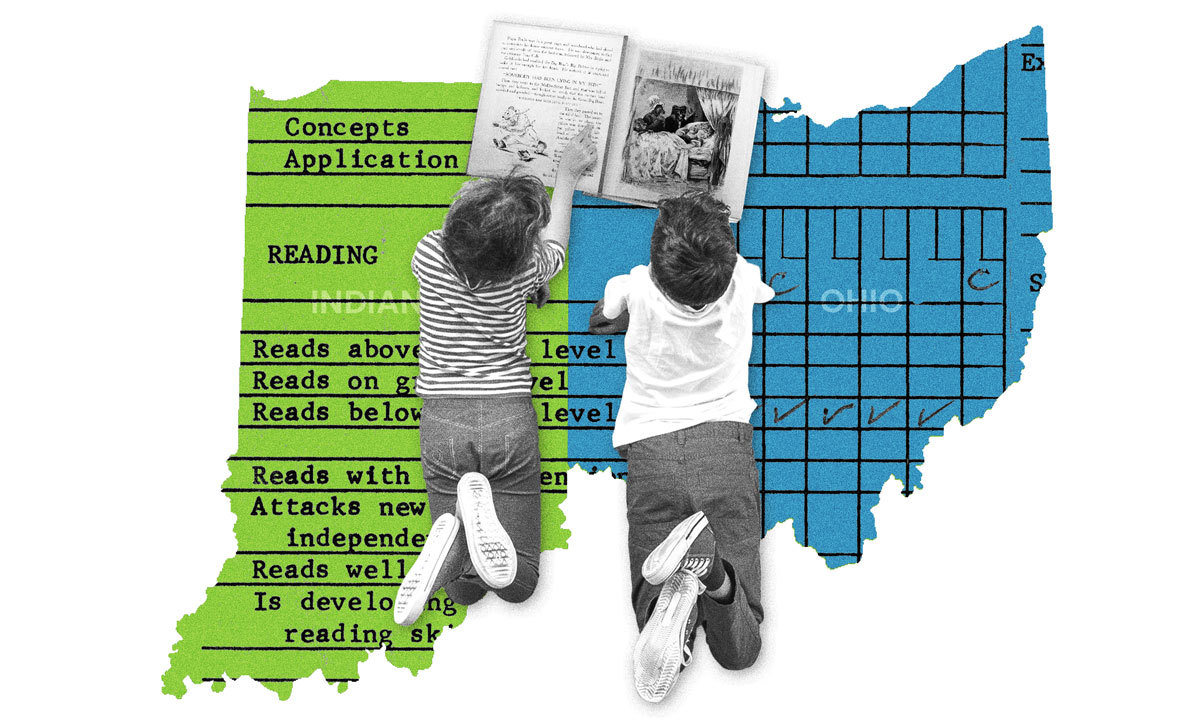To Hold Back Struggling Readers or Not: Indiana & Ohio Take Different Paths
The neighboring states are counting on the science of reading to solve reading woes, but veer far apart on retaining low-scoring third graders.

Get stories like these delivered straight to your inbox. Sign up for The 74 Newsletter
Indiana and Ohio joined the growing number of states last year mandating teachers use the science of reading, but the neighboring states have gone in opposite directions with another reading strategy — holding back struggling third graders.
In Ohio, where students who scored poorly on state reading tests had to repeat third grade for the last decade, the state legislature ended the requirement last summer in a bill that also adopted the science of reading.
In Indiana, state officials just restored mandatory retention of low-scoring third graders after a seven year absence. Gov. Eric Holcomb signed a law this month requiring students that don’t score as proficient on the state’s IREAD-3 tests to be held back in third grade, with few exceptions. The state estimates the new law will hold back 18 times as many third graders when it takes effect in 2025 — 7,500 compared to just over 400 today.
Third grade retention and science of reading are two strategies for improving reading that have sparked similar excitement – more than a decade apart – and a rush of states to adopt them. Both Ohio and Indiana joined the third grade retention movement in 2012, though Indiana later backed away before rejoining it this spring and Ohio never fully embraced it.
Both states have also seen reading scores drop on NAEP, the “nation’s report card,” even before the pandemic, then decline more after. Such results make it only natural for legislatures to shift gears, experts said.
“Third grade is obviously a critical moment,” said American Enterprise Institute senior fellow Robert Pondiscio. “There’s nothing to be gained by giving kids more of what hasn’t worked. It should trigger different, intensive efforts.”
He and others like Timothy Shanahan, professor emeritus at the University of Chicago, said the key is not just adopting something that sounds good, but making sure it changes classroom instruction.
Both Ohio and Indiana seem to be covering those bases, with more teacher training, new textbooks, and other student supports. Whether those are enough and how well they are used by teachers, schools and parents is still to be determined.
Right now, the desire for immediate change, particularly in Indiana, is clear.
“About one in five students in Indiana can’t read effectively by the end of third grade,” said Indiana State Rep. Linda Rogers, one of the law’s authors. “This is not acceptable. If a child hasn’t learned basic reading skills by that point in school, they’re going to struggle to learn almost every other subject.”

Indiana education superintendent Katie Jenner told the legislature the state can’t have 14,000 third graders scoring below proficient on Indiana’s IREAD-3 test, as happened in 2023, without taking real steps to catch them up.
“The students who are just moving on are never passing. Ever. Ever,” Jenner said. “It’s hard to say that, but it’s honest.”
Indiana’s new law also requires more testing of second and third graders to identify struggling readers and for more interventions, such as l summer reading classes after second and third grade for students who are behind.
Jenner said adding these interventions and the retention mandate is a natural second step in the state’s literacy plan after focusing on having the right reading lessons through the science of reading and training teachers to teach them last year.
Requiring students to repeat third grade after not passing reading tests became law in California in 1998, rising to national prominence after Florida adopted the policy in 2002 under then-Gov. Jeb Bush. Since then, several states have passed similar laws, though with differing policies on which students – such as special education, English Language Learners or students who have already repeated a grade – are exempt.
All shared a similar reasoning: Third grade is where students usually shift from ”learning to read to reading to learn,” or needing to read well enough they can read and learn other subjects. Students need to master reading by then, backers argued, or they will fall behind in 4th grade and beyond or may never learn to read. Mandatory retention also gives students, parents and teachers a deadline for taking reading seriously.
The strategy has promising early results, with some studies showing students making strong reading gains in the first few years after retention, though gains often faded by high school. Some of the most dramatic results came in Indiana under an earlier version of third grade retention that was dropped in 2017, a Brown University study showed.
But opponents in multiple states raised objections each time bills were introduced, usually citing studies that show smaller gains and psychological damage to students who are held back because of teasing, feelings of failure and being separated from friends. The studies have also noted Black and Hispanic students are usually held back at higher rates than white students.
Indiana was an early state in the third grade retention movement when former state superintendent Tony Bennett pushed for it in 2010. The legislature did not agree, but the state board of education mandated it with an administrative rule in 2012.
The Indiana Department of Education eased that requirement in 2017-18, telling schools to consider student performance in all subjects, even if not scoring well in reading, to decide if a student should move to fourth grade.
Third grade reading also had big changes in 2012 in Ohio, when then-Gov. John Kasich won approval from Ohio’s state legislature for his “Third Grade Reading Guarantee” that required more tests to identify students having trouble reading and for schools to hold back students who score poorly.
Unlike Indiana, which always made proficiency the threshold for promotion, Ohio set a lower score that needed to be raised over time. That set off constant debates each time the state school board had to decide how much to increase the score. Over time, the score crept higher but too many board members had reservations for the needed score to ever reach the proficiency level.
About 3,600 students were held back each year under Ohio’s retention law before several Republicans joined Democrats in opposing it last year.
“Instead of a one-size-fits-all approach to literacy that currently exists, (a change) will give local and parental control to districts when deciding to retain a child,” Republican Rep. Gayle Manning told legislators in pushing an opposition bill last year.
In the end, a joint House and Senate committee chose to give parents the final say in holding back their children as part of a compromise state budget bill. Though many Ohio Senate Republicans wanted to keep the retention requirement, they relented because the bill included the shift to the science of reading and a requirement that students keep receiving extra reading help until they can catch up.
“I wasn’t in favor of it (ending retention), but we put some things in that I wanted,” said Senate Education Committee Chairman Andrew Brenner, also a leading backer of science of reading. “I think that will help immensely to get kids back on track over the next couple of years.”
The Ohio Department of Education and Workforce does not yet know how many students avoided retention this fall because of the law change.
In Indiana, attempts by Democrats to give parents the final say in whether a child has to repeat third grade, like Ohio decided last year, were voted down by Republicans. Attempts to delay the law until the state could see how science of reading changes affect scores also were voted down.
Get stories like these delivered straight to your inbox. Sign up for The 74 Newsletter


